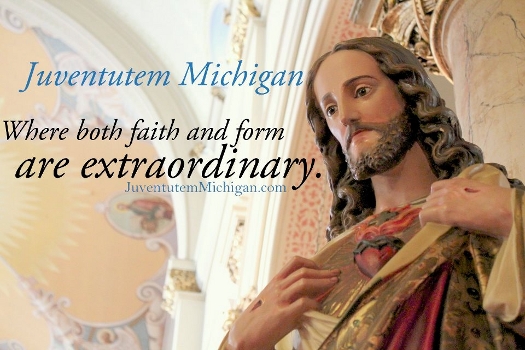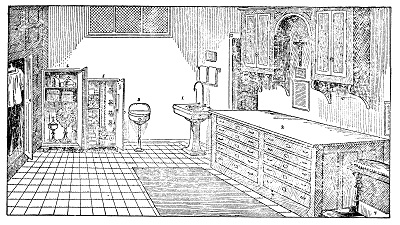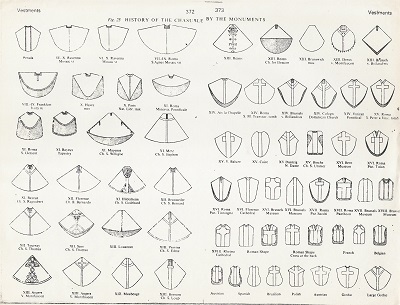
"I will go in unto the Altar of God
To God, Who giveth joy to my youth"
Tridentine Community News by Alex Begin (October 16, 2016):

October 16, 2016 – Twenty-second Sunday After Pentecost
The Sacristy and Its Arrangement
A church’s sacristy might seem to be a place of mystery to many Catholics. Relatively few have reason to venture into a sacristy, and those who do generally have a purpose in mind, usually talking to the priest. Indeed, the sacristy is typically the domain of the altar servers, sacristans, and those in charge of laundering the altar linens. Let’s take a look around and see what’s typically in there.
The accompanying diagram from Fr. William O’Brien’s book, In Sacristy and Sanctuary, depicts many of the [numbered] key objects found in a typical sacristy: 1) The sink, not to be confused with 3) the sacrárium, a special sink which drains into the ground rather than the sewer. The sacrárium is used to dispose of Holy Water, excess Precious Blood, water in which dropped Hosts have been dissolved, and in general any liquid which has been blessed. 2) The sacristy table contains drawers for altar linens, certain types of vestments and vestment parts (stoles, maniples) that can be stored flat, and supplies of all sorts. Older churches may have one or more framed prayer cards above the table, containing Vesting Prayers and Prayers Before and After Mass. Above the sink in older churches is often found the Prayer Before Washing Hands. All of these prayers are in Latin and are said by the celebrant while vesting before a Tridentine Mass. In newer churches they are provided on portable, framed cards.
5) The incense cabinet, containing the thurible, charcoal, incense, matches, the incense boat, and related supplies.
6) The safe, containing the cibória (containers for the Hosts), chalices, monstrance, reliquaries, and related precious metallic objects.
Vestments and altar servers’ cassocks and surplices are stored in closets, sometimes in a separate sacristy room on the other side of the sanctuary (the “work sacristy”, meant for servers, as opposed to the main “priest’s sacristy”).
There is always a Crucifix in the sacristy, meant as a focal point for prayer. Before Mass, the servers and celebrant all face the Crucifix while the priest says, “Procedámus in pace.” [Let us go in peace], to which the servers respond, “In Nómine Christi. Amen.” [In the Name of Christ. Amen.] After Mass, all bow to the Crucifix and say “Deo grátias.” [Thanks be to God], then the servers kneel and ask for the celebrant’s blessing, saying, “Jube, domne benedícere.” [Your blessing, Father.]
You are welcome to come explore the sacristy after Mass; please ask one of the altar servers to give you a tour.
Chasuble Shapes
The chasuble is the large outer vestment that the celebrant wears during Mass. There are three principal kinds of chasubles:
1) The Roman or “fiddleback” chasuble, so named because it is the regional norm in Rome and has a front side shaped like a cello, or fiddle [Shouldn’t it be “fiddlefront”?]. The back side is squared off. These days, most Tridentine Mass sites employ fiddleback chasubles, as their level of artistic design is typically more expressive and elaborate.
2) The Gothic chasuble is the type most commonly seen nowadays at Ordinary Form Masses. They are robe-like, longer in the front and back, and shorter on the sides for the arms.
3) The rarely seen Conical chasubles are circular pieces of fabric with a hole in the center for the head to go through. They are most commonly used in monasteries.
Tridentine Masses This Coming Week
- Mon. 10/17 7:00 PM: Low Mass at St. Josaphat (St. Margaret Mary Alacoque, Virgin)
- Tue. 10/18 7:00 PM: High Mass at Holy Name of Mary, Windsor (St. Luke the Evangelist)
- Sat. 10/22 8:30 AM: Low Mass at Miles Christi (Saturday of Our Lady)




No comments:
Post a Comment